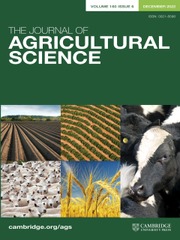Article contents
The effects of site and season on the fate of nitrogen residues from root crops grown on sandy soils
Published online by Cambridge University Press: 01 June 1997
Abstract
In 74 experiments carried out in England from 1990 to 1994, cereal test crops were grown on sandy soils prone to nitrate leaching, following cereals, sugarbeet and potatoes. Measurements were made of the effects of the previous crops on soil mineral N, and on N recovery by the cereal test crop.
Soil N supply in autumn (SNSa) was greater following potatoes (c. 100 kg/ha N) than following sugarbeet or cereals (c. 60 kg/ha N). However when potato crops to which organic manures had been applied were excluded, mean SNSa after potatoes was only c. 60 kg/ha. Soil N supply in spring (SNSs) following sugarbeet and potatoes was similar and at c. 56 kg/ha, c. 10 kg/ha greater than following cereals. Seasonal differences in SNSs were related to excess winter rainfall and soil water-holding capacity. Modelled leaching losses gave good agreement with overwinter changes in SNS (r=0·87), although SNSs was usually greater than predicted by the model. This discrepancy was considered to be due to overwinter mineralization, which was estimated from the intercept of the regression lines to be c. 40 kg/ha following cereals and potatoes, and c. 50 kg/ha following sugarbeet.
Apparent net mineralization (AM) of N during the test crop growing season was c. 37, 53 and 63 kg/ha following cereals, sugarbeet and potatoes respectively. However, AM was c. 24 kg/ha N greater if the preceding potato crop had been given organic manures, but there was no difference in AM following manured and unmanured sugarbeet crops.
Nitrogen offtake by the cereal test crop without fertilizer N (NoffN0) was c. 15·20 kg/ha greater following potatoes and sugarbeet than following cereals. The greater N offtake following potatoes is considered to be due to mineralization of organic manures applied to the potato crop, while the effect following sugarbeet appears to be due to mineralization of sugarbeet residues. At harvest, SMN was c. 38 kg/ha and similar for all three previous crops. It is concluded that mineralization of sugarbeet residues has taken place more quickly on these sandy soils than previously reported on soils of greater clay content. Only potatoes grown with organic manures leave greater N residues than cereals.
Information
- Type
- Research Article
- Information
- Copyright
- © 1997 Cambridge University Press
- 12
- Cited by

